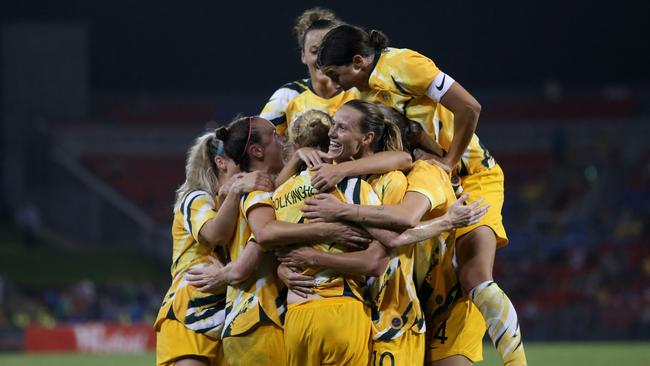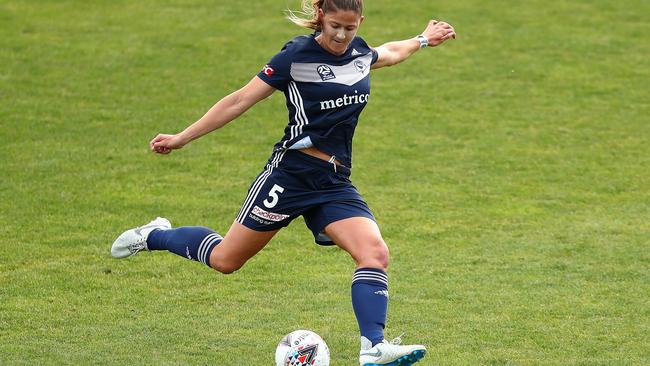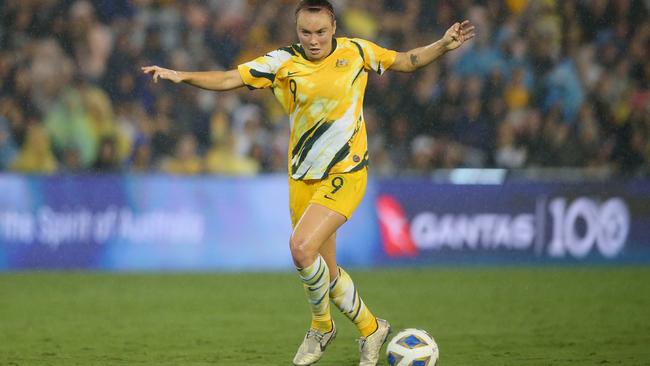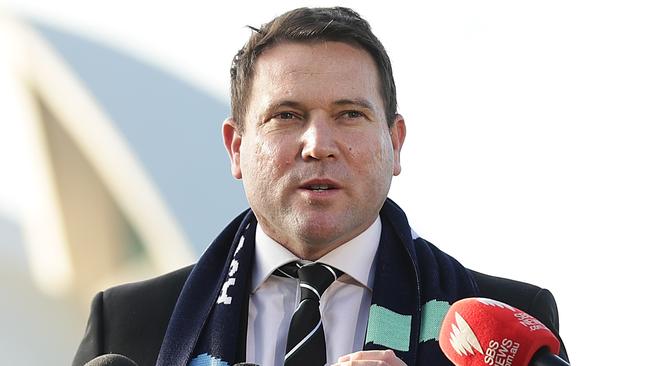Matildas waltz towards World Cup
Diehard fans, talent to burn, a World Cup coming up on home turf. The sky’s the limit for the Matildas — and it’s a key deal in 2015 that set the scene.

“Gosh,” says Laura Brock, recalling the bad old days of 2015 when the Matildas were forced to go on strike to put food in their fridges. “That seems like a lifetime ago.” The changes she’s witnessed in Australian women’s football are almost too profound to seem real. Just a generation before, in the lead-up to the Sydney Olympics, the players posed naked for a calendar to raise money, and the team’s profile. Now, the Matildas can let their skills do the talking. They’re fast catching up to their male counterparts, the Socceroos, and are a more marketable brand than the Wallabies. With a do-or-die playing style and wholesome image, they’ve amassed an army of loyal followers of mums and dads and kids. They’re a sponsor’s delight. And their exuberant captain, Sam Kerr, is an international superstar to whom brands such as Nike are hitching their wagons.
In 2023, along with New Zealand, Australia will host the Women’s World Cup – the biggest sporting event after the men’s cup and the Olympics. And it’s a trophy the Matildas are more than capable of winning. The suffragettes of sport have hit a purple patch and they are not done yet. “It’s probably something that I should reflect on more often,” says Brock, a veteran of the team. “Be more appreciative of just how far we’ve come.”
Back in 2015 Brock (then Laura Alleway), a tough and dogged defender for the Matildas, was struggling to keep her head above water. She’d been playing for the Brisbane Roar and living rent-free in a flat her folks owned in Noosa; the $200 a week she was paid by the club didn’t even cover the petrol money for the drive to train in Brisbane four nights a week. She’d been attempting to hold down part-time jobs as a swimming coach and behind the counter at Rebel Sport, while whittling away at a back-up plan, studying to become a teacher. Once, when she was on tour representing her country, she had to phone her parents to transfer cash as she was down to her last couple of hundred dollars.

In 2015 Brock and her teammates went on strike, cancelling a sellout tour of the US and passing up a chance to play the world’s best team. Their stance was criticised by some, but it has paid dividends and last year they signed a landmark deal with Football Federation Australia (FFA) that put them on equal footing with the Socceroos – one of only a handful of countries where this equality has been achieved. The entire squad of 20 is now paid a wage. The details have not been made public but insiders say players are paid a yearly fee, based on a three-tiered system – $87,000 for the top players, $60,000 for the middle tier and $35,000 for those at the bottom.
The parity deal has been a game-changer. “It has meant that I haven’t had to worry about money and where my next pay cheque is coming from,” says Brock. It’s making a huge difference to the professionalism of the squad. “Money talks, right,” she says. “So not only do we have confidence in ourselves, but we now have the backing of our governing body, saying they believe in us and that they believe we can go ahead and win the World Cup.”
As we are talking, Brock, who played with Melbourne Victory during the Australian season, is packing her bags to fly to France and take up a contract with Guingamp in the Division 1 Féminine. Her teammates are now playing with the world’s biggest clubs: Mackenzie Arnold for West Ham United, Lydia Williams and Steph Catley for Arsenal, Ellie Carpenter for Olympique Lyonnais, Sam Kerr for Chelsea, Alex Chidiac for Atlético Madrid, Emily van Egmond for Orlando Pride…

Veteran commentator and former Socceroos captain Craig Foster says that to be successful at a World Cup you need a majority of the team playing at the best clubs. “That builds the winning capacity, not just a winning mentality, that actually leads to winning with your country in a World Cup... The rise of the Matildas is assisting the entire game in Australia.”
The Matildas currently sit at No. 7 in the FIFA world rankings but Brock believes this vastly undervalues the quality of the team. In the 2019 World Cup in France they made it through to the round of 16 only to be defeated by Norway in a penalty shootout. For a team that fancied its chances, that was a significant disappointment, especially in light of what had happened barely six months earlier. Alen Stajcic, who had been head coach since 2014, was removed in January last year amid claims of a “toxic culture” in the dressing room. The clean image of the Matildas brand took a hammering from media headlines, and FFA was forced to publicly clarify that Stajcic had been sacked for football reasons – in short, to give the team its best chance at the World Cup. Former Socceroo Ante Milicic came in at short notice and was popular with the players, but getting knocked out in the last 16 of a tournament was hardly a ringing endorsement of the decision to fire Stajcic. Now Milicic has himself moved on. At the time of publication the FFA was in the final stages of signing a coach who it hopes can take the team to the World Cup.
That home-soil event presents the sport with an opportunity to create a world-class women’s league, the premier league in Asia, that some dare hope might eventually muscle up to the old sporting giants of rugby league, AFL and even cricket. The sisters are doin’ it for themselves.

It was with a great deal of trepidation that Australia embarked on its bid for the Women’s World Cup after the humiliating debacle of Qatar. In 2010, after spending more than $45m of taxpayers’ money on a bid for the 2022 men’s World Cup, Australia was knocked out in the first round after receiving just one vote. Qatar went on to win in a process that was rotten to the core. This and other events would ultimately lead to the resignation of powerful FIFA president Sepp Blatter and to a slew of corruption charges against football officials relating to Russia’s and Qatar’s bids for the 2018 and 2022 men’s World Cups. In the end, however, all this would prove vital for Australia’s successful 2023 bid.
The newly appointed CEO of Football Federation Australia, James Johnson, watched the dramatic changes taking place within football’s governing body from inside the FIFA tent. Johnson was a promising junior from Brisbane who played in the U17 Australian side and went on to captain the Brisbane Strikers. With a law degree under his belt, he embarked on an international career in football administration, working for the Asian Football Confederation and for FIFA in Zurich in roles that put him on first-name basis with the heads of national football associations around the world. The contacts in Johnson’s phone would prove invaluable in the final frantic weeks in the lead-up to the vote by the FIFA Council in Zurich in June.
When we meet with Johnson at FFA headquarters in Sydney, he explains that the changes he witnessed following the removal of Sepp Blatter were momentous. Blatter had run the organisation as his personal fiefdom. Many of the staff had worked for FIFA for decades and were loyal to the president rather than to the good governance of the sport. And then Blatter was ushered out in disgrace, the locks were changed and in came the reformist Swiss-Italian Gianni Infantino. “It became much more professional, much more corporate,” Johnson says. “Gianni liked people who could deliver outcomes.” He smashed the old clans and set about uprooting the systems that had allowed corruption to flourish.
The Infantino reforms sought to take the processes out of the shadows. The votes of each of 30-odd members of the FIFA Council, including his own, would be made public when the bid was announced. Each potential host nation would be subjected to a rigorous technical evaluation and would be scored on the commercial viability of their bid, as well as the quality of their stadiums and facilities and a host of other criteria. And so, in a radical shift for FIFA, the bid would be decided on the quality of the candidate and its suitability to host the World Cup, rather than the quantity of cash in a suitcase. “If you look at the last two bidding processes, for the 2026 men’s World Cup and this one, the processes were actually really well governed,” says Johnson. “They were very transparent. They were disciplined. They were consistent. There was a lot of objectivity.”

The other ace Australia held was New Zealand. “If you look at Gianni’s philosophy, he’s always been big on competitions that are organised across borders,” says Johnson. “He’s big on unifying and coming together. For the 2026 men’s World Cup he preferred the Americas bid, which was Mexico, United States and Canada.” Initially, Australia and New Zealand were competitors for the women’s 2023 World Cup, but last year they decided to join forces. Australia is in the Asian Confederation, NZ in Oceania, and it would mean that if the bid were successful the Cup would be held across two confederations for the first time.
New Zealand Football president Johanna Wood says that when Australia and New Zealand joined forces it presented FIFA with “a really strong commercial option” by giving it the opportunity to spread the games across the two sports-mad countries. It also doubled the bid’s lobbying capacity. Wood sits on the FIFA Council and while she had to abstain from the vote, it didn’t stop her pressing her case. There had been pressure to delay the decision – Brazil, one of the candidates, was in the grip of the Covid pandemic and Japan was grappling with having to delay the Olympics until 2021. Wood and FFA chairman Chris Nikou met with Infantino and pressed the case for moving the process forward. “We said that if you push it out any further it means that the host nation, whoever it may be, will have less time to prepare,” she says. Brazil eventually withdrew, followed by Japan, citing problems associated with the delay of the Olympics and the “strength of the joint Australia-New Zealand bid”.
That strength had become apparent when an expert FIFA panel of five flew south in February, first to Australia and then to New Zealand. A few months later, the delegation published its findings. Australia/New Zealand scored 4.1 out of 5, Japan 3.8 and Colombia 2.8. When Japan pulled out, it seemed we had it in the bag. The Asian votes that may have gone to Japan would swing to the ANZ bid. The intense lobbying went on at the highest levels until the day of the vote in June. And there were some worrying, late-breaking dramas.
In the days leading up to the vote New Zealand Prime Minister Jacinda Ardern attempted to phone English Football Association chief Greg Clarke, but Clarke refused to take the call. Officials in New Zealand and Australia were stunned. England had been lobbying for years for FIFA to clean up its act. Technically, the joint bid was far superior to the Colombian one but when it came time for England to put its ethics to the vote, the English delegate went with Colombia. Johnson was ropable. “I conveyed that disappointment to the English FA,” he says. He never got a reply. The antipodean bid romped home with 22 of the 35 votes for the right to hold the biggest sporting event here since the 2000 Olympics.

Hosting a World Cup will blast the Matildas into the stratosphere. In the lead-up, the dramas of who’s in, who’s injured, who’s in love – as well as the preparations for the cup – will play out across the media. Rob Mills, CEO of the international sports marketing group Gemba, says the Matildas are fast catching up to the Socceroos. Using a measure of team marketability he calls “asset power”, Mills says the Matildas have grown to become a bigger brand than the Wallabies. “While the Wallabies are still more well known, what drives a higher asset power for the Matildas is the emotive draw of the team – their likeability.”
It comes at a time when the A-League, the men’s game, finds itself in deep trouble. Research from Roy Morgan has shown that in the past year viewership in the A-League has slumped 15 per cent. Conversely, a record 879,000 Australians watched the W-League on TV this year, up 265,000 on a year ago. The popularity of the women’s game inevitably, and rightly, leads to talk about equal pay – something that has been achieved in the national teams but not at club level. The women in the W-League are paid a fraction of what their male counterparts in the A-League are paid. Former Socceroos captain Craig Foster says a hard deadline of 2023 should be set for equal pay between the men’s and women’s leagues using the cash windfall from the World Cup.
Australian striker Caitlin Foord says that with many of the Matildas now playing for teams in Europe and the US, great opportunities have opened up for the next Sam Kerr or Steph Catley. “Each year the W-League has grown, bit by bit,” says Foord, who also headed to Europe this year to hone her skills. “Now, with a lot of the national team players going overseas, I think it’s going to open up a massive opportunity for the young players to step up, get some game time.” She adds that a strong W-League is vital for Australia’s chances at the World Cup.
As a young girl playing football, Foord never idolised the Matildas because she didn’t even know they existed. “I wasn’t aware of who the Matildas were when I started playing,” she says. “I just played because I enjoyed it. I didn’t grow up watching women’s football, no one in my family did.” At the age of just 25, Foord has already represented Australia at three world cups.

The women’s game has grown enormously since she debuted in the W-League in 2009. “Fast forward to 2023, everything is going to take off again [for women’s soccer] in Australia,” Foord says. “To have the best players in the world here in our country, it’s going to be massive not only for women’s football, but for football in general.” And, she says, the Matildas can win. “It would be incredible to do something special on home soil.”
Her captain, Sam Kerr, says the next hurdle for the Matildas is for the FFA to appoint the very best coach. “Women’s football is already very strong in Australia,” Kerr says. “There’s obviously always room for improvement, but we are just going about our way, playing the brand of football we like. We need to keep winning and producing players like Ellie Carpenter, Caitlin Foord and Emily van Egmond. These are players that the fans love and they’ll rock up to the stadiums to watch them.” The stadiums, she says, will be pumped come 2023.

To join the conversation, please log in. Don't have an account? Register
Join the conversation, you are commenting as Logout